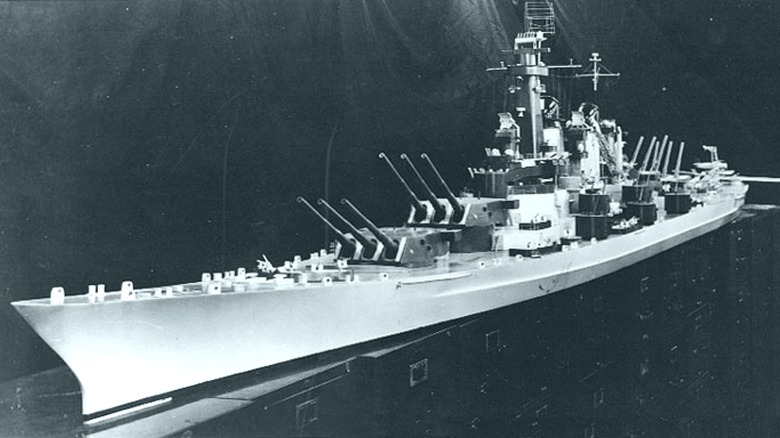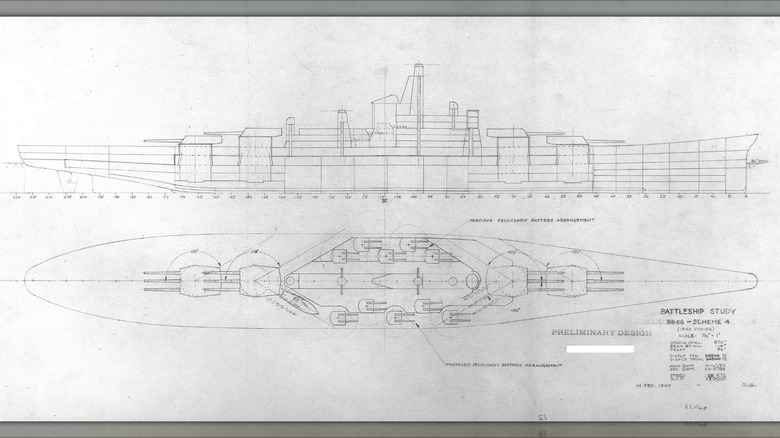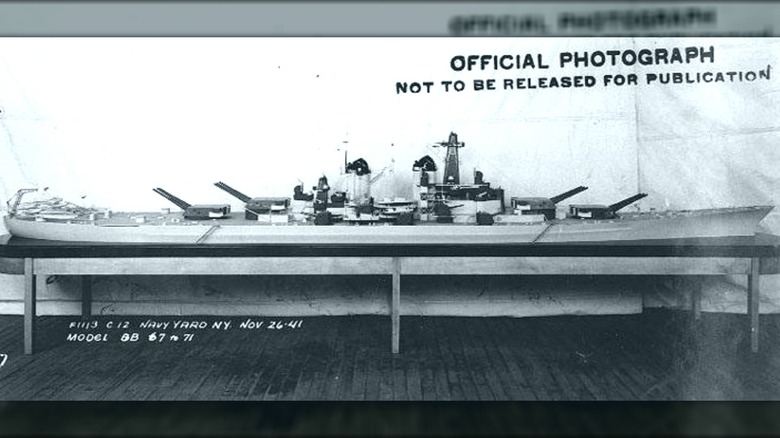The Montana-Class Battleship: The Most Powerful Warships Never Built
When the United States and its allies entered World War II, the Iowa-class battleship quickly proved its worth on the world's oceans. Typically, battleships would accompany Essex-class aircraft carriers, and they brought the pain wherever they sailed. Iowa-class battleships were massive floating vessels outfitted with nine 16-inch guns that could fire on other vessels or pound targets on land up to 27 miles away. The U.S.' last battleship, the USS Missouri, was easily one of the most significant ships of WWII.
This made the U.S. fleet of battleships some of the deadliest in the world, but the Iowa class wasn't the only one considered for inclusion in naval operations. In 1939, before the U.S. entered the war, plans for another class, the Montana-class battleship, made its way through the approval process. Unfortunately for that class, which would have produced the largest battleships in America's arsenal, the Japanese sneak attack at Pearl Harbor delayed the project's construction.
Because America's carrier fleet survived Pearl Harbor by being elsewhere during the attack, that class of vessel rose to prominence and remains the cornerstone of global naval operations. When WWII came to an end, the battleship was on its last leg, and the Montana-class would never be built, as money and people were diverted to constructing more carriers. Had the USS Montana been constructed, it would have resulted in America's largest and most lethal battleship ever made, but its fate was sealed by the Japanese before it could get off the ground.
[Featured image by Unknown via Wikimedia Commons | Cropped and scaled | Public Domain]
Five Montana-class Battleships were approved
Congress approved the construction of five Montana-class battleships, which would have resulted in the commissioning of the USS Montana (BB-67), USS Ohio (BB-68, USS Maine (BB-69), USS New Hampshire (BB-70), and the USS Louisiana (BB-71). These vessels would have been constructed in Philadelphia, New York, and Virginia, but their keels were never laid down, which is the initial step in naval ship construction.
Had the U.S. built these ships, it would have entered WWII with 17 battleships, making it the largest fleet in the world. That would have given the U.S. a greater advantage over the Japanese Imperial Navy, even with its larger and deadlier Yamamoto-class battleships, of which they had two. The Yamamoto-class vessels were larger and came equipped with bigger main guns, but the loss of the battleship fleet at Pearl Harbor required an adjustment in strategy and tactics.
That ultimately worked, and the Japanese Imperial Navy was all but destroyed by the end of World War II. While none of the planned Montana-class battleships were constructed, they were fully designed and would have been larger and more lethal than Iowa-class battleships. They would have also been better defended and slower, as their design traded speed for the ability to survive similarly-powered vessels, making them the deadliest and most defendable ships in the Navy had they been built.
[Featured image by U.S. Navy via Wikimedia Commons | Cropped and scaled | Public Domain]
The Montana-class Battleships would have packed a punch
The Montana-class battleship plans differed from the Iowa-class in several notable ways, largely around the areas of offense and defense. While the Iowa class boasted nine 16-inch 50 cal. guns on three turrets, the Montana would have had 12 16-inch guns of the same class in four three-gun turrets with two on either side of the conning tower. These guns would have fired shells weighing up to 2,700 lbs. at a maximum effective range of 27 miles at a rate of two rounds per minute.
Additional armaments included 20 five-inch guns, up to 32 anti-aircraft guns, and 20 anti-aircraft cannons, giving it 25% more firepower than Iowa-class battleships. While having more guns is nice, the biggest difference, other than the Montana outweighing the Iowa-class battleships by around 10,000 tons, was its intended armor. Adding more armor to the ship would have made it heavier and slower, which was a tradeoff the Navy didn't mind.
Montana-class battleships would have featured different thicknesses of armor on different parts of the ship. The main belt would have sported 16.1" armor, while the standard bulkheads were 18" forward and 15.25" aft. The gun emplacement armor would have been 21.3" and 18", while the turret face's armor would have been the thickest at 22.5" The main deck's armor was the thinnest, averaging to 9.92". Unfortunately, circumstances ensured it never saw the light of day, but had the vessels been constructed, they would have been impressive, to say the least.
[Featured image by Unknown via Wikimedia Commons | Cropped and scaled | Public Domain]


